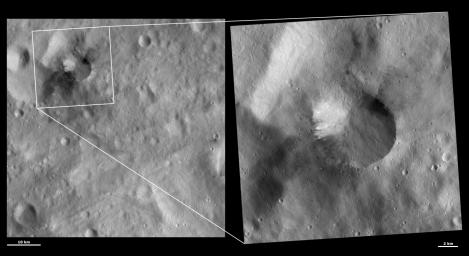
|
HAMO and LAMO Images of Occia Crater
- Click the image above for a larger view
- Full-Res JPEG (2200 x 1200) (277.1 kB)
- Full-Res TIFF (2200 x 1200) (2.6 MB)
Caption:
These Dawn framing camera (FC) images of Vesta show Occia crater at both HAMO (high-altitude mapping orbit) and LAMO (low-altitude mapping orbit) resolutions. The left image is the HAMO image and the right image is the LAMO image. Occia is the crater centered in the LAMO image. The LAMO image is approximately three times better spatial resolution than the HAMO image. In images with higher spatial resolutions smaller objects can be better distinguished. The dark material around the top right and bottom left rim of Occia is more clearly seen in the HAMO image. This is probably due to the two images being taken under different illumination conditions because the visibility of Vesta's dark material is quite dependent on the illumination conditions. However, much more detail can be seen inside of Occia crater in the LAMO image, such as tiny craters and streaks developed from material slumping towards the center of the crater.
These images are located in Vesta's Gegania quadrangle, in Vesta's southern hemisphere. NASA's Dawn spacecraft obtained the left image with its framing camera on Oct. 28, 2011. This image was taken through the camera's clear filter. The distance to the surface of Vesta is 700 kilometers (435 miles) and the image has a resolution of about 68 meters (223 feet) per pixel. This image was acquired during the HAMO (high-altitude mapping orbit) phase of the mission. NASA's Dawn spacecraft obtained the right image with its framing camera on Jan. 25, 2012. This image was taken through the camera's clear filter. The distance to the surface of Vesta is 272 kilometers (169 miles) and the image has a resolution of about 21 meters (69 feet) per pixel. This image was acquired during the LAMO (low-altitude mapping orbit) phase of the mission.
Background Info:
The Dawn mission to Vesta and Ceres is managed by NASA's Jet Propulsion Laboratory, a division of the California Institute of Technology in Pasadena, for NASA's Science Mission Directorate, Washington D.C. UCLA is responsible for overall Dawn mission science. The Dawn framing cameras have been developed and built under the leadership of the Max Planck Institute for Solar System Research, Katlenburg-Lindau, Germany, with significant contributions by DLR German Aerospace Center, Institute of Planetary Research, Berlin, and in coordination with the Institute of Computer and Communication Network Engineering, Braunschweig. The framing camera project is funded by the Max Planck Society, DLR, and NASA/JPL.
More information about Dawn is online at http://www.nasa.gov/dawn and http://dawn.jpl.nasa.gov .
Cataloging Keywords:
| Name | Value | Additional Values |
|---|---|---|
| Target | 4 Vesta | |
| System | Main Belt | |
| Target Type | Asteroid | |
| Mission | Dawn | |
| Instrument Host | Dawn | |
| Host Type | Orbiter | |
| Instrument | Framing Camera (FC) | |
| Detector | ||
| Extra Keywords | Crater, Grayscale | |
| Acquisition Date | ||
| Release Date | 2012-08-23 | |
| Date in Caption | 2011-10-28 | 2012-01-25 |
| Image Credit | NASA/JPL-Caltech/UCLA/MPS/DLR/IDA | |
| Source | photojournal.jpl.nasa.gov/catalog/PIA15865 | |
| Identifier | PIA15865 | |
